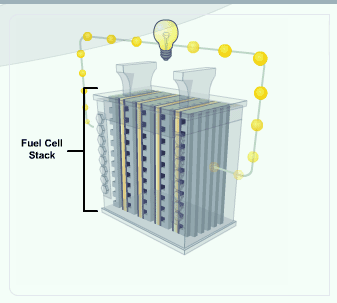 |

Fuel cell:
The amount of power produced by a fuel cell depends on several factors, including fuel cell type, cell size, temperature at which it operates, and pressure at which the gases are supplied to the cell. A single fuel cell produces less than 1.16 volts - barely enough electricity for even the smallest applications.
next | top
Fuel cell stack:
To increase the amount of electricity generated, individual fuel cells are combined in series, into a fuel cell "stack." A typical fuel cell stack may consist of hundreds of fuel cells.
next | top
Fuel cells are a flexible technology and have a broad range of applications:
Transportation:
Fuel cells can be used to provide propulsion or auxiliary power for transportation applications including cars, trucks, buses, trains, ships, and submarines. They have been used to provide auxiliary power on spacecraft for decades.
Stationary Power:
Stationary fuel cell units can be used for backup power, power for remote locations, stand-alone power plants for towns and cities, distributed generation for buildings, and co-generation (in which excess thermal energy from electricity generation is used for heat).
Portable Power:
Fuel cells can be used to power a variety of portable devices, from handheld electronics like cell phones and radios, to larger equipment such as portable generators. They can be used for almost any application typically powered by batteries but can last up to three times longer before refueling.
top |
 |









